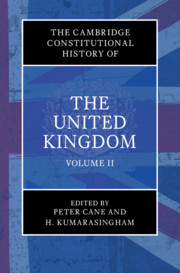Book contents
- The Cambridge Constitutional History of the United Kingdom
- The Cambridge Constitutional History of the United Kingdom
- Copyright page
- Contents
- Contributors
- Editors’ Preface
- 1 The Kingdoms of Anglo-Saxon England (450–1066)
- 2 England after the Conquest
- 3 England in the Thirteenth Century
- 4 England in the Fourteenth Century
- 5 England in the Fifteenth Century
- 6 England in the Sixteenth Century
- 7 The English Constitution in the Seventeenth Century
- 8 A European Perspective
- 9 Wales before Annexation
- 10 The Scottish Constitution before 1707
- 11 The Eighteenth-Century Constitution
- 12 The Constitutional and Parliamentary History of Ireland till the Union
- 13 The United Kingdom in the Nineteenth Century
- 14 The United Kingdom in the Twentieth Century
- 15 The Twenty-First-Century Constitution
- 16 Wales since the Annexation
- 17 Scotland in the Union
- 18 Ireland in the Union
- 19 The Making of Empire
- 20 Constitution and Empire
- Index
13 - The United Kingdom in the Nineteenth Century
Published online by Cambridge University Press: 12 August 2023
- The Cambridge Constitutional History of the United Kingdom
- The Cambridge Constitutional History of the United Kingdom
- Copyright page
- Contents
- Contributors
- Editors’ Preface
- 1 The Kingdoms of Anglo-Saxon England (450–1066)
- 2 England after the Conquest
- 3 England in the Thirteenth Century
- 4 England in the Fourteenth Century
- 5 England in the Fifteenth Century
- 6 England in the Sixteenth Century
- 7 The English Constitution in the Seventeenth Century
- 8 A European Perspective
- 9 Wales before Annexation
- 10 The Scottish Constitution before 1707
- 11 The Eighteenth-Century Constitution
- 12 The Constitutional and Parliamentary History of Ireland till the Union
- 13 The United Kingdom in the Nineteenth Century
- 14 The United Kingdom in the Twentieth Century
- 15 The Twenty-First-Century Constitution
- 16 Wales since the Annexation
- 17 Scotland in the Union
- 18 Ireland in the Union
- 19 The Making of Empire
- 20 Constitution and Empire
- Index
Summary
The rough chronological boundaries of this chapter will be 1800 and 1921. These are defined by the structure of the United Kingdom, which itself defined the key questions in constitutional history that were discussed in this period. In 1800 the island of Ireland, all thirty-two counties, joined Great Britain, which had been formed in 1707 by the Union between Scotland and England. This was the period of the maximum extent of the United Kingdom. In 1921, following the negotiations at the end of the Irish War of Independence, the island of Ireland was partitioned, twenty-six counties forming the Irish Free State and the six remaining counties in the north-east constituting Northern Ireland. The government of Northern Ireland was subject to a scheme of devolution under the Government of Ireland Act of 1920. This had provided for both northern and southern parliaments, only the former was established.1 It remained in place until the imposition of direct rule in 1972. The nineteenth century, therefore, was an age of two unions and this had huge significance for constitutional developments.2 Not only were the Unions themselves matters of great controversy but the three kingdoms, four nations, posed immense problems in relation to questions of church and state, local government, the land and the issue of the extension of the franchise. The constitutional development of the United Kingdom of Britain and Ireland was complex. The Union state incorporated several constitutional traditions and understandings of the constitution, and a range of challenges to its integrity. The British constitution, most often seen in terms of an English constitutional tradition, was thought of by contemporaries implicitly and explicitly in a comparative context.
- Type
- Chapter
- Information
- The Cambridge Constitutional History of the United Kingdom , pp. 317 - 342Publisher: Cambridge University PressPrint publication year: 2023



